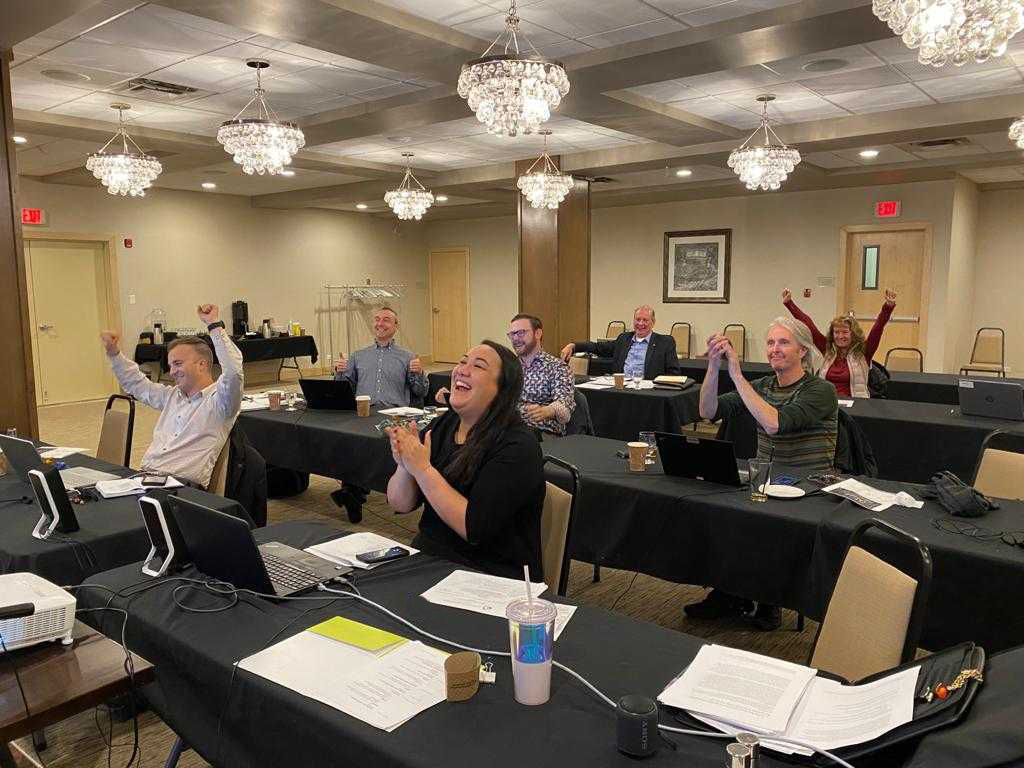When the leaves start to fall from the trees, chambers from across Canada know it is time to submit policy resolutions of a national scope to the Canadian Chamber of Commerce on behalf of the business community they represent – including Kamloops.
Policies cover a wide range of issues brought forward by chambers from coast to coast to coast, discussing everything imaginable, from – Circular Economies of Plastics to Child Care Credits for SMEs – policies often provoke lively debate before they are eventually voted on at the Canadian Chamber of Commerce AGM, including the Kamloops Chamber’s Land Trust Initiative – a homegrown policy aimed at tackling Canada’s affordable housing crisis has passed the vote.
The Land Trust Initiative looks to mirror a similar model that is used for ecological land reserves, essentially applying the framework that is currently used for ecological land reserves to affordable housing – currently, a disincentive exists for individuals or corporations who would consider donating land due to crippling Federal Tax Law, which makes tackling affordable housing a constant uphill battle across the country.
We recently caught up with Colin O’Leary, Principal at O’Leary & Associates Ltd. and Kamloops Chamber Board Member, who has led the Land Trust Initiatives advocacy efforts to learn more about where the idea came from and how we can tackle affordable housing across Canada.

Colin, the Land Trust Initiative recently passed at the Canadian Chamber of Commerce AGM – a policy you personally worked on. How did this policy come to fruition?
This policy was born out of the work my father had started in Alberta (as a volunteer) in a campaign to end homelessness. He was a corporate lawyer with Burnet, Duckworth & Palmer, was one of the founding board members for the Calgary Homeless Foundation (which still lists him as an honorary board member) and actually helped to start many of the land trusts in Canada (including the Calgary Community Land Trust, now rebranded as HomeSpace Society).
The idea of the land trusts was to mimic a proven model which has worked in other countries around the world. It is very innovative in its approach, which makes it not only indefinitely sustainable, but actually tackles the problem at its core and in a way that no other model offer.
A Community Land Trust is a non-profit organization created to acquire and hold land for the benefit of the community. To do so, the trust acquires land and maintains ownership of it permanently. With prospective homeowners, it enters into a long-term (most frequently, 99 years), renewable lease instead of a traditional sale. When the homeowner sells, the family earns only a portion of the increased property value. The remainder is kept by the trust, preserving the affordability for future low- to moderate-income families.
The first Community Land Trust was established in Canada in the 1970’s as a means to preserve the affordability of cooperative housing and to pool resources of isolated co-ops. There are currently over a hundred Community Land Trusts across Canada.
The problem was, that shortly after they started all of these land trusts, they realized a rather large problem – a tax problem, which was specific to Canada. Without going into detail (which is explained in the policy) – there is a dis-incentive for individuals and corporations to donate land to a land trust. Without land donations, these existing land trusts are severely hampered in their ability to provide affordable housing.
My father had explained this to me in the past and I realized, as an adult, that this could be something I could help to fix, using the power of policy through the Chamber. Hence this policy.
 Chamber Members Voting on Local Policy Resolutions at the Kamloops Chamber of Commerce AGM & Policy Session (Photo by Kim Anderson Photography)
Chamber Members Voting on Local Policy Resolutions at the Kamloops Chamber of Commerce AGM & Policy Session (Photo by Kim Anderson Photography)
In the policy, it mentions that Community Land Trusts are crippled by Federal Tax Law? What is the current issue with Federal Tax Law that needs to be remedied to help an initiative like this take flight?
Many corporations and private landowners currently hold property as an outcome of normal day to day life. These land acquisitions are sometimes used for business operations but can also be held as passive income or for future growth. With the increase in real-estate valuation in many cities across Canada over the last 30 years, the real estate appraisal value of these parcels of land have most often increased, sometimes dramatically.
These individuals and corporations have a strong disincentive to donate these lands to a Community Land Trust because the tax credit or offset generated by the donation does not overcome the tax owing from the capital gain. The result is that individuals and corporations will give up the ownership and value of the property AND owe tax for doing so.
The result is many parcels of land which are held in perpetuity or sold to other individuals, which could otherwise be used by Land Trusts or other non-profit organizations to address the affordable housing crisis in Canada.

In the policy it mentions that Ecological Land Reserves can be used as a precedent for this type of initiative. What have you learned from Ecological Land Reserves that can be applied to Affordable Housing? Will this have the same impact?
In the 2006 Budget, the federal government proposed and to completely eliminate the capital gains tax on certain gifts of publicly listed securities and ecologically sensitive land.
The idea behind these measures was to provide the charitable sector with a “powerful set of tools” for raising funds and encouraging charitable giving. Donors would not be taxed on any of the capital gain accrued on the donated property and would receive the full benefit of the donation tax credit on the donation.
Has this incentive proved successful? Since 2006, according to the 2015 Federal budget, close to $1 billion worth of ecological land has been donated for conservation efforts using this mechanism.
Much thought and revisions were required for the Income Tax Act to enact this piece of legislation. Furthermore, additions and revisions have been put in place over the years which has resulted in robust anti-avoidance rules and a proven mechanism to incentivize land donation by individuals and corporations for ecological conservatories.
Where else in the world do Community Land Trusts exist? Has it been successful? Why or why not?
The community land trust (CLT) is a model of affordable housing and community development that has slowly spread throughout the United States, Australia, Belgium, Bolivia, Brazil, Canada, Kenya, New Zealand, Europe, and the United Kingdom over the past 50 years. There are currently an estimated 280+ CLTs in the United States, 255 in the UK and hundreds more in other countries around the world.
Some examples of very successful CLT’s globally include:
New Communities, Inc., the prototype for the modern-day community land trust, was formed in 1969 near Albany, Georgia, by local leaders of the Civil Rights Movement who were seeking a new way to achieve secure access to land for African American families.
One of the earliest and most influential CLTs in the United States is the Burlington Community Land Trust (BCLT) in Vermont, which was founded in 1984 as an initiative led by Mayor Bernie Sanders. The BCLT was a response to rapidly increasing housing costs that threatened to price out many long term residents of the city. BCLT is now known as the Champlain Housing Trust (CHT) and is currently the largest CLT in the US and is still operating today. As of 2018 the Champlain Housing Trust’s assets were valued at $144 million, with more than 6,000 people sleeping in CHT properties every night.
Other notable CLTs in the US include the Dudley Street Neighborhood Initiative which was granted the power of “eminent domain” by the City of Boston. More recently in June 2019 the City of New York set aside $750,000 in budget just to provide technical support for fledgling Community Land Trusts so that they can utilize the $13 million secured by the city for CLTs. New York knows first hand the proven power of CLTs with the city’s oldest, the Cooper Square Mutual Housing Association. To date, it has expanded to some 400 apartments and 20 small businesses.
Looking more internationally, one cannot overlook Cano Martin Pena CLT in San Juan, Puerto Rico which received the World Habitat Award in 2015. Organized by the World Habitat international charity in partnership with UN-Habitat, the award highlights innovative and replicable housing solutions across the world. In 2017, the Caño CLT was one of six finalists of the Buckminster Fuller Award, which calls attention to initiatives that are creatively addressing the world’s most pressing issues. The Buckminster Fuller Institute considered the Caño CLT to be truly revolutionary, inspiring other communities in Brazil, Ecuador, Paraguay, Peru, and South Africa to pursue similar paths. In 2018, the Caño CLT was one of ten initiatives selected for the Communities Thrive Challenge grant. Sponsored by the Rockefeller Foundation and the Chan Zuckerberg Initiative. The Caño CLT success has been reported and praised widely by international news outlets such as Rolling Stone, Next City, The Guardian, and numerous others.
Other examples include:
Sustainable Housing for Inclusive and Cohesive Cities (SHICC), a cross-national association funded by the European Union, was created in 2017 under the leadership of CLTs in Brussels, Ghent, London, and Lille.
In the Global South, CLTs in Kenya and Puerto Rico have spurred new interest in applying the model to the challenge of regularizing land tenure in informal settlements, like the favelas of Brazil.
If this policy moves forward, who are the people that will benefit the most from this policy? How will it affect them? What is the effect it will have on the community and business community?
Since the early 1990s, the incidence of Canadians experiencing homelessness has risen dramatically to an estimated 235,000 people each year. Yet only 2% of this number, roughly 5,000 people are “unsheltered”, which defines what the average Canadian thinks of when they think of a homeless person (absolutely homeless, living on the street, or in places not intended for habitation).
This means that the remaining 98% of Canadians experiencing homelessness are comprised of people in emergency shelters (those staying in overnight shelters intended for people who are homeless or fleeing domestic violence); and those who are provisionally accommodated (those whose accommodation is temporary or lacks long term security).
Additionally, one in five Canadian households are at risk of homelessness, meaning that these households spend more than 50% of their income on rent. It is estimated that the costs associated with homelessness (i.e., social services, emergency healthcare, shelters, policing) are in excess of $7 billion annually.
In addition to the above-mentioned homelessness issues, three significant gaps in Canada’s housing continuum exist today:
1. A lack of transitional housing between emergency shelters and social housing. This gap tends to strand individuals and families in a state of homelessness.
2. An acute shortage of “near-market” housing, occurring between social housing and entry-level market housing. This gap prevents families and individuals living in social housing from successfully entering the regular housing market.
3. A readily available supply of affordable entry-level housing in most major metropolitan centers. These are often young, working families, who without affordable entry-level housing options bear housing costs that represent a dangerously high proportion of their income. For these families, one single event – such as job loss, divorce, illness, accident, addiction or a reduction in social support – could be enough to tip the delicate balance and create a downward spiral potentially leading to homelessness.
Besides the dramatic need for affordable housing, as mentioned above, Corporations and Individuals will also benefit from this policy as it will allow them to make Philanthropic donations of land for affordable housing without being hit by a large tax bill for doing so. Furthermore, with this policy, they will be able to use the tax credit or deduction to offset their other income.
In more simple terms: they can use the value of the land they donated to offset their tax owing, similar to a normal charitable donation. Right now, unlike a cash donation to the Canadian Red Cross, where you would get a tax receipt – if you donate land to a CLT you would be taxed on making that donation (the capital gain tax on the property) and get a tax receipt. The problem is that the tax owing is often more than the value of the tax receipt – which means you would be donating (giving up) a parcel of land and have to pay tax for doing so, more than the value of your tax receipt! Who would do that? The answer is: almost no one. This is the part we are trying to amend with this policy.
 The Kamloops Chamber Board and Staff cheer as the Land Trust Initiative passes the vote at the Canadian Chamber of Commerce virtual AGM in October 2020.
The Kamloops Chamber Board and Staff cheer as the Land Trust Initiative passes the vote at the Canadian Chamber of Commerce virtual AGM in October 2020.
For people unfamiliar with the Chamber, briefly explain how this concept went from an idea in Kamloops to passing at the Canadian Chamber of Commerce AGM?
The Chamber has a little-known superpower and that is the power of policy and advocacy! By taking a real-life issue, bringing it to the Chamber and creating a draft policy (short document that describes the problem and the proposed solution), the Chamber has a unique opportunity to bring this policy forward whatever level of government is most appropriate. For this policy, we first had to get support locally, then present and have it supported at the Provincial Chamber, before being presented nationally at the Canadian Chamber. If it is adopted, the Chamber will advocate and has the “ear” of the politicians and bureaucrats to make it into law.
Let me say that last part again – you have the power, through the Chamber network, to change the law in Canada to make it a better place for everyone. Sounds too good to be true right?
Well, consider this: The Canadian Tax-Free Savings Account (which is right across Canada) was an idea that came from an individual right here in Kamloops and the Kamloops Chamber of Commerce pushed it up through the network and now it is available to all Canadians right across the country!
That is the power of policy, that is the power of the Chamber network.

Colin O’Leary,
Principal at O’Leary & Associates
Board Member for the Kamloops Chamber of Commerce
